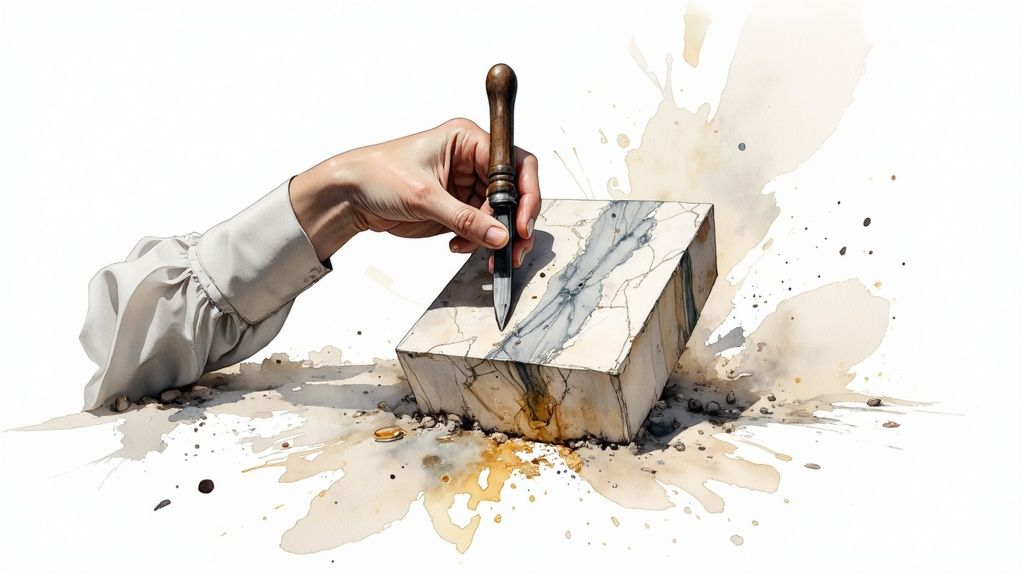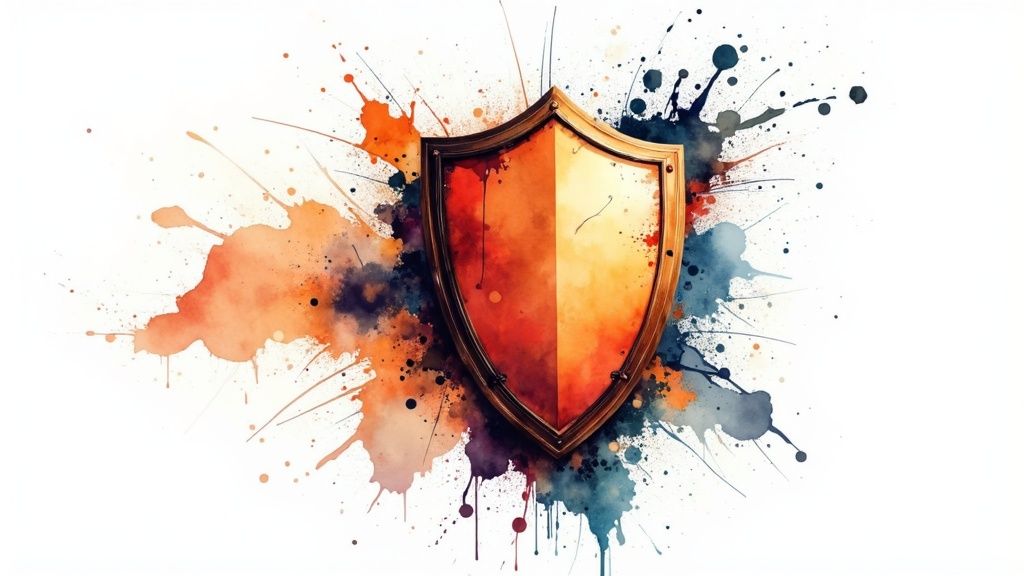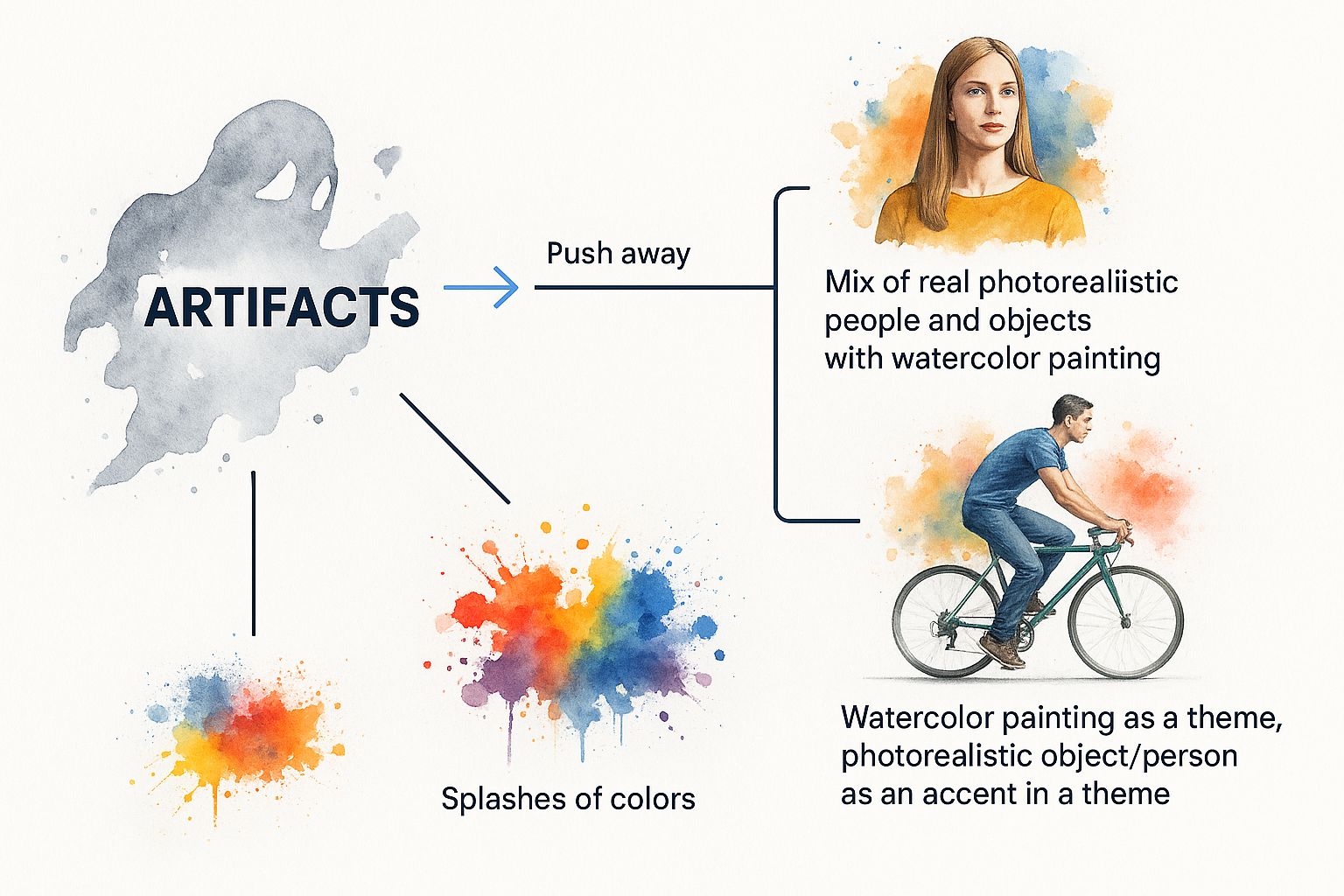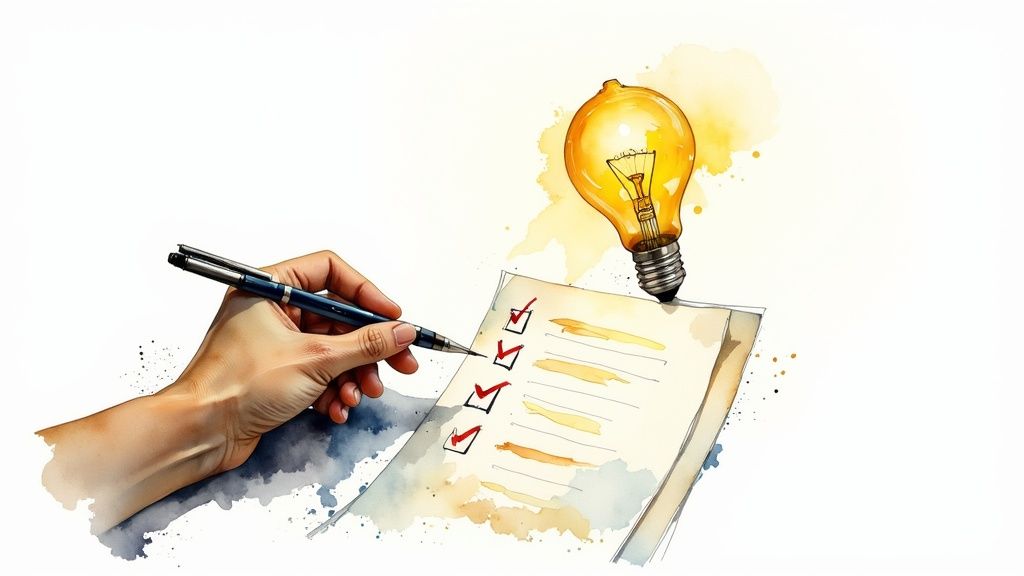Mastering Stable Diffusion Negative Prompts

A Stable Diffusion negative prompt is your way of telling the AI what you don't want to see in an image. Think of it as a creative filter, helping you steer the model away from common headaches like blurry textures, extra fingers, or ugly watermarks to drastically improve your final result.
What Are Negative Prompts and Why They Matter

Imagine you're commissioning a painting. You'd tell the artist what you want, sure, but you'd probably also mention what to avoid. Maybe you'd specify "no gloomy colors" or "keep it away from a modern art style." That’s exactly how negative prompts work in Stable Diffusion. They act as your creative co-pilot, guiding the AI toward your vision by clearly marking which paths to ignore.
This isn't just a simple filter slapped on at the end, either. It’s an active part of the image creation process. The AI considers both your positive prompt (what to make) and your negative prompt (what to leave out) simultaneously, making smarter decisions at every step to produce a much more refined image.
The Rise of Negative Prompts
When Stable Diffusion first hit the scene in August 2022, it was a game-changer. But early users quickly ran into a problem: positive prompts alone often generated some pretty weird stuff. Common issues included strange artifacts and malformed anatomy—especially hands. In fact, up to 32% of early face generations had noticeable abnormalities like extra fingers.
This challenge is what led to the widespread adoption of negative prompts. Today, 65% of AI artists report getting significantly better image quality when they use them. The payoff is huge, with some artists cutting their need for post-production edits by as much as 40%.
A negative prompt is the chisel that carves away imperfections. While the positive prompt provides the marble block of an idea, the negative prompt refines its shape, ensuring the final sculpture is exactly what you envisioned.
Getting a handle on this dual-prompt system is fundamental to creating high-quality AI art. Before we dive deeper, it helps to understand the broader field of prompt engineering, which is all about the art of guiding AI models to get specific results. Having that foundational knowledge makes mastering negative prompts a lot more intuitive.
How Negative Prompts Guide the AI Generation
So, how do negative prompts actually work their magic? Let's skip the dense, technical jargon for a minute.
Think of the AI's creative process like a sculptor starting with a massive, unformed block of marble. This block contains every possible version of your image. Your positive prompt is the instruction to the sculptor—"I want a statue of a heroic figure."
The stable diffusion negative prompt, then, is the chisel. It's the tool that actively carves away everything you don't want to see.
This isn't some simple filter slapped on at the end. Instead, negative prompts are an active guidance system that influences the image from the very first spark of creation. At each step, the model looks at both your positive and negative instructions, constantly trying to strike a balance. It actively steers the generation away from the concepts in your negative prompt, making sure those unwanted elements never even get a chance to form.
This is a great way to visualize it: the negative prompt acts as a repulsive force, pushing away artifacts and unwanted concepts to sharpen the final image.

As the infographic shows, this guidance prevents weird stylistic clashes and gets rid of common AI imperfections. The end result is a much cleaner, higher-quality piece that's closer to what you actually envisioned.
The Sculpting Process in Action
This back-and-forth gives you a powerful layer of control over the final output. It's how you can fix common AI mistakes, fine-tune the overall vibe, and get rid of distracting objects with surprising precision.
- Fixing Flaws: If you toss "mutated hands, extra fingers" into your negative prompt, the AI will actively avoid creating anatomical shapes that look anything like that.
- Refining Aesthetics: Want a vibrant, sunny day? Negatively prompting "dark, gloomy, overcast" pushes the generation toward a much brighter color palette.
- Removing Objects: If you need a clean portrait, adding "crowd, other people, background objects" tells the AI to focus exclusively on your main subject, leaving the background uncluttered.
You can think of a negative prompt as a "vector" pointing away from a concept in the AI's vast internal map of ideas. Each negative term you add gives the generation a little nudge, guiding the final image toward a cleaner result by subtracting what you don't want.
Of course, before you can truly master what to subtract, it helps to get a solid handle on what to add. For a deep dive into the other half of the equation, check out this excellent guide on mastering Stable Diffusion prompts.
This constant negotiation between "give me this" and "don't give me that" is precisely what makes negative prompts so incredibly effective. For more ideas, you can always browse through thousands of successful image prompts to see how other creators are balancing these inputs.
By using this "sculpting" method, you stop being a passive observer and become an active artist, shaping the AI’s creation with far greater intent and accuracy.
Crafting Powerful and Effective Negative Prompts

Alright, let's move from theory to practice. This is where you really start to take the reins. Writing a powerful stable diffusion negative prompt isn’t about stuffing it with every word you can think of; it's about being strategic with the right words.
The secret is to be specific. You need to give the AI clear guardrails without completely boxing in its creativity.
Think about it this way: telling the model to avoid "bad hands" is just too vague. What does "bad" even mean to an algorithm? But, if you tell it to steer clear of "mutated hands, extra fingers, poorly drawn hands, fused fingers," you're giving it concrete problems to avoid. That kind of specific feedback is what separates a mediocre image from a masterpiece.
This idea holds true for everything. Instead of just saying "low quality," you'll get far better results with a negative prompt like "blurry, jpeg artifacts, pixelated, low resolution, grainy." Each term targets a distinct visual flaw, giving you surgical control over the final output.
Building a Universal Starter Prompt
While every creation is different, you'll find that many AI images stumble over the same common hurdles. That’s why so many artists rely on a universal "starter" negative prompt. It’s like a safety net that catches the most frequent issues right out of the gate.
From there, you can add or subtract terms to fit the unique needs of your image.
A solid starter prompt usually tackles three core areas:
- Quality Control: Words to fend off blurriness, artifacts, and low-res junk.
- Anatomy and Form: Terms to fix the classic AI weirdness with hands, limbs, and faces.
- Distractions: Instructions to get rid of unwanted text, watermarks, or signatures that the AI sometimes hallucinates.
By layering these categories, you build a robust foundation that instantly boosts the quality of almost any image you generate. It saves a ton of time and gives you a much higher-quality baseline to work from.
The end goal is to have a reliable toolkit you can turn to. For a deeper dive into the strategies behind building prompts like these, check out our guide to mastering AI prompt engineering—the principles apply just as much to telling the AI what not to do.
Common Categories of Negative Prompts
To help you get started building your own go-to prompt, I've broken down some of the most common and effective negative prompt terms into categories. Think of this table as a quick-reference cheat sheet you can pull up whenever you're wrestling with a tricky generation.
Common Categories of Negative Prompts
| Category | Example Negative Prompts | Purpose |
|---|---|---|
| Quality Issues | worst quality, low quality, jpeg artifacts, blurry, grainy, pixelated, low res | Prevents common visual degradation and ensures a crisp, clean final image. |
| Anatomy Issues | bad anatomy, deformed, extra limbs, extra fingers, fused fingers, long neck, malformed | Corrects frequent AI mistakes related to human or animal bodies. |
| Facial Flaws | poorly drawn face, ugly, asymmetrical, distorted features, cloned face | Refines facial structures and expressions for more realistic portraits. |
| Unwanted Objects | text, watermark, signature, username, logo, banner | Removes distracting or unwanted elements that can clutter the composition. |
Once you start using these targeted terms, you stop just hoping for a great result and start actively guiding the AI toward it. This is what effective AI art creation is all about.
Common Mistakes That Weaken Negative Prompts
Using stable diffusion negative prompts is an incredibly powerful technique, but if you're not careful, they can do more harm than good. Getting a handle on the common pitfalls is the key to avoiding frustration and creating consistently great images. Most beginners run into the same few errors, and they’re all easy to fix once you know what to look for.
Prompt Contradiction
One of the most frequent mistakes is prompt contradiction. This is what happens when your negative prompt directly fights a core idea in your positive prompt. It's like telling a chef to bake a chocolate cake but then adding, "Oh, and don't use any cocoa."
Let's say your positive prompt is "a vibrant red sports car." If you then turn around and add "red" to your negative prompt, you’ve created a paradox. The AI gets conflicting instructions and will likely spit out a bizarre, discolored, or just plain incoherent image as it tries to obey both commands at once. Always give your prompts a quick once-over to make sure your negative terms aren't canceling out your main subject.
Vague Instructions vs. Specific Commands
Another classic issue is using terms that are way too vague. A negative prompt filled with words like "bad quality," "ugly," or "poorly made" doesn't give the AI much to work with. The model doesn't have a human's subjective understanding of what "ugly" means.
Instead of being vague, get specific. Pinpoint the exact flaws you want to stamp out.
- Vague:
bad quality - Specific:
blurry, jpeg artifacts, pixelated, low resolution, grainy
This level of detail gives the AI clear, technical parameters to avoid, which almost always results in a much cleaner output. The more precise your instructions, the better the AI can follow them.
A well-crafted negative prompt acts like a list of specific allergies for the AI. "Bad food" is unhelpful, but "no peanuts, no gluten, no shellfish" provides actionable instructions that guarantee a better outcome.
The Problem of Overloading
It’s tempting to throw every negative term you can think of into the prompt, hoping to build a fortress against all possible flaws. But overloading the negative prompt often backfires. When you give the AI too many restrictions, you can completely stifle its creativity. This can lead to overly simplistic or strange, "baked" images that feel unnatural and lack any interesting variation.
The best approach is to start with a solid base of essential quality and anatomy terms. From there, add more specific negatives only if you see a persistent problem popping up in your generations. If you're struggling to fix common issues, checking out a collection of prompts designed to fix generations can give you great examples of targeted, effective commands.
The goal is surgical precision, not a brute-force attack. By sidestepping these common mistakes, your negative prompts will become a reliable tool for refinement, not a source of confusion.
Once you've got the basics down, it's time to start using stable diffusion negative prompts with a whole new level of precision. These advanced techniques are all about grabbing fine-grained control over your images. We're talking about fixing those stubborn little flaws and even bending the entire style of your artwork with just a few clever commands. It’s like moving from a paintbrush to a fine-tipped engraving tool.
One of the most powerful tools you can add to your kit is prompt weighting. This technique lets you turn the "volume" up or down on any term in your negative prompt.
Let's say you're generating a portrait, but the AI keeps messing up the hands. It's a classic problem. Just adding poorly drawn hands to your negative prompt might not cut it; the model could still get it wrong.
This is where weighting comes in. You can emphasize that specific instruction to make sure the AI listens. The syntax can vary a bit depending on your interface, but it usually looks something like this: (poorly drawn hands:1.4). The number acts as a multiplier. Here, you're telling the AI to pay 1.4 times more attention to that command. This can be a total game-changer for those persistent issues a standard negative prompt just can't seem to shake.
Using Negative Prompts for Stylistic Control
But negative prompts aren't just for damage control—they're a formidable tool for shaping the entire aesthetic of your image. Instead of just removing what's wrong, you can use them to subtract a whole style, forcing the AI down a completely different creative path. This is where you go from being a director to a true art curator.
Imagine you want to create a classic, flat-color anime character, but your positive prompt keeps spitting out images with photorealistic lighting and textures. You can use a negative prompt to surgically remove those unwanted qualities.
- Positive Prompt:
anime girl, high school uniform, smiling - Advanced Negative Prompt:
(photorealistic:1.3), realistic, 3d render, detailed shading, hyperdetailed, soft lighting
By negatively prompting the very terms that define realism, you're steering the AI away from that entire look. It's forced to lean much more heavily on the "anime" part of your positive prompt, giving you the crisp lines and flat colors you wanted from the start. It’s a subtractive method for achieving a very specific artistic vision.
Using negative prompts for style is like creating a vacuum. By removing one dominant aesthetic, you force another to rush in and fill the empty space. It gives you incredible control over the final look and feel of your artwork.
Case Study: Fixing a Common Generation Flaw
Let's walk through a real-world example. Say we want a cool picture of a knight, but the AI keeps throwing in distracting, modern junk and producing a blurry, low-quality result.
Initial Attempt:
- Positive Prompt:
knight in shining armor, fantasy art - Negative Prompt:
blurry - Result: The image is still a mess. It has weird textures and digital artifacts, and it completely lacks that sharp, epic feel we're going for.
Now, let's bring in some advanced weighting and more specific negative terms to clean this up.
Improved Attempt:
- Positive Prompt:
knight in shining armor, fantasy art - Negative Prompt:
(blurry:1.5), (jpeg artifacts:1.2), modern, sci-fi, text, watermark, signature, poorly drawn face - Result: The improvement is dramatic. By increasing the weight on "blurry" and adding specific terms to kill off artifacts and unwanted styles, the final image is sharper, cleaner, and perfectly locked into the fantasy genre.
This kind of control has a real economic impact, too, since it drastically cuts down on the need for manual edits later on. Some creative agencies report that using advanced negative prompts can slash post-processing time by 30–50%. For a mid-sized studio, that could translate into savings of up to $300,000 annually. You can learn more about how these techniques are driving efficiency in the creative industry. These methods aren't just about making better art; they’re about making it smarter and faster.
Your Questions About Negative Prompts, Answered
Let's dig into some of the most common questions artists and AI enthusiasts run into when working with negative prompts. Think of this as your personal FAQ for troubleshooting and getting unstuck.
The goal here is to give you quick, practical answers so you can solve problems fast and get back to what matters—creating incredible art.
What Is the Best Universal Negative Prompt to Start With?
While every project has its own needs, a fantastic starting point is what I call a "quality and anatomy" negative prompt. This is a single string that tackles the most common, nagging flaws you see in AI images, giving you a solid foundation for just about any generation.
A great starter negative prompt usually includes terms like:
low quality, worst quality, blurry, jpeg artifactsugly, deformed, bad anatomy, extra limbs, mutatedpoorly drawn hands, poorly drawn face, disfiguredwatermark, signature, text, username
Think of this combo as your first line of defense. It's incredibly effective at filtering out the most frequent AI hiccups right from the start.
Can a Negative Prompt Guarantee Removal of an Object?
It gets you incredibly close, but it’s not a 100% guarantee. Negative prompts are powerful tools for steering the AI away from a concept, making its appearance highly unlikely. Where they start to struggle, though, is when a negative term directly contradicts the main subject of your positive prompt.
For instance, if your positive prompt is "a dense forest" but your negative prompt includes "trees," you're giving the AI a paradox it can't solve. The instructions are fundamentally at odds.
Negative prompts are at their best when you're trying to remove secondary elements, stylistic quirks, or unwanted artifacts—not when you're trying to negate the very essence of your image.
Does the Order of Words in a Negative Prompt Matter?
Absolutely. Just like with positive prompts, most Stable Diffusion models pay more attention to the words that come first. The AI essentially prioritizes avoiding the first few concepts you list.
So, if mangled hands are the biggest issue you're facing, putting poorly drawn hands, bad anatomy right at the beginning of your negative prompt tells the AI to make that its top priority. Shuffling your negative keywords around is a surprisingly effective way to fine-tune your final image.
Think of your negative prompt as a "don't-do" list for the AI. The items at the top of the list get the most attention. Reordering your terms is a simple yet powerful way to shift the AI's focus.
How Do I Know if I Am Using Too Many Negative Prompts?
The tell-tale sign of overdoing it is when your images start looking weird, overly simplified, or what the community calls "baked." A 'baked' image is one that looks over-processed, stiff, and has lost all of its natural, organic feel. If the AI is spitting out abstract messes or things just feel off, you've likely cornered its creativity too much.
A good rule of thumb is to start with a standard quality prompt and only add specific terms to fix problems you actually see in your outputs. If your results get worse after adding a new keyword, you've found your culprit. It's all a balancing act between giving clear direction and leaving enough room for the AI to get creative.
Ready to find and share your own powerful prompts? At PromptDen, you can explore a massive library of high-quality prompts for Stable Diffusion, Midjourney, and more. Join our community to find inspiration, sell your best creations, and take your AI art to the next level. Find your next masterpiece at https://promptden.com.